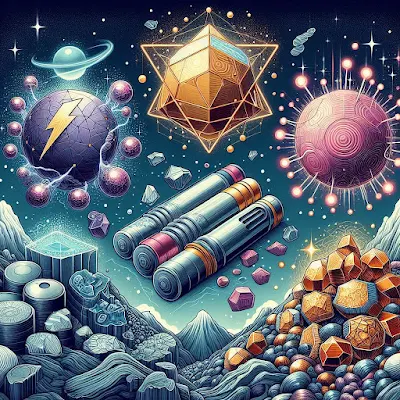FIVE CRITICAL MINERALS AND METALS
FIVE CRITICAL MINERALS AND
METALS: MARKET TRENDS, ROLE IN CLEAN ENERGY, AND CANADA'S POSITION IN THE
GLOBAL SUPPLY CHAIN
The development and implementation of new technologies are usually linked to specific materials. Currently, five minerals are driving the industry forward due to their irreplaceable role in clean energy technologies, electronics, and industrial applications on a global scale.
These are Lithium, Copper, Nickel, Cobalt, and the set of Rare Earth Elements (REEs).
Data from early 2025 indicates that global lithium production increased from just over 737,000 tonnes in 2022 to almost 1.2 million tonnes in 2024 (lithium carbonate equivalent, LCE). Lithium is a critical component of batteries in Electric Vehicles (EVs), smartphones, and energy storage systems. Predictions hold that by 2040, the demand might increase eightfold mainly due to the rise of EVs. Although Australia and Chile lead in lithium production, China dominates refining operations.
Copper, an essential metal in electrical infrastructure, EVs, solar, and wind energy systems, is projected to have the largest market value among energy transition minerals. The International Energy Agency (IEA) projects that by 2040, copper will have the largest market value among energy transition minerals, reaching approximately $330 billion. It is further estimated that its demand might double by 2030, with Chile, Peru, and the Democratic Republic of Congo known as top producers. BMO Capital Markets estimates that, without significant substitution or thrifting, copper demand could reach 40.4 million tonnes per year by 2030, up from 31.8 million tonnes in 2022.
Nickel is a key player in EV batteries and stainless steel. Global primary nickel usage in 2024 was approximately 3.35 million metric tons, an increase of around 5% from 2023.The demand for nickel in EV batteries is indeed projected to increase significantly in the coming years. Estimates often range from 15-20% annual growth through 2030. Indonesia has become the dominant global nickel producer, with production estimated to be around 2.2 million metric tons in 2024.
Cobalt, another critical element for EV batteries, smartphones, and aerospace, increased its demand by 8-15% in 2024.The Democratic Republic of Congo (DRC) remained the overwhelmingly dominant source of global cobalt supply in 2024, estimated to account for over 80% of the total mine production. However, ethical and environmental concerns surrounding cobalt mining in the DRC persisted and remained a significant issue in 2024.With 70% of global supply coming from Congo, ethical and environmental concerns in mining drive interest in alternative sources like Canada.
Canada continued to be viewed as an important potential alternative source of ethically sourced cobalt. In 2024, Canada's cobalt production saw an increase of around 11%. While the overall production volume is still significantly lower than the DRC's (estimated at around 4,900 tonnes in 2023, with a likely increase in 2024), there is ongoing investment and development in Canadian cobalt projects.
Lastly, the group of Rare Earth Elements (REEs), including neodymium, praseodymium, dysprosium, and terbium, crucial for EV motors, wind turbines, and high-tech applications, is also in high demand. Their unique magnetic properties make them indispensable in these sectors. China controls 60% of their mining and 90% of the subsequent processing.
This dominance by China in both mining and processing, coupled with surging demand and geopolitical considerations, continues to make REEs a central focus for governments and industries worldwide
In essence, these minerals and metals are increasingly commanding attention due to soaring demand, geopolitical supply chain concerns, and limited production capacity thus guiding investment and strategic policies in 2025.
Notably, Canada is flexing its muscles as a key player in global mining, boasting production, exploration, and exportation of critical minerals such as copper, nickel, cobalt, lithium, and REEs.
As well as being a top producer, Canada is home to advanced mineral projects and a key exporter. In 2024, Canada's domestic exports of metal and non-metallic mineral products reached approximately CAD 141.9 billion. This represented roughly 20.8% of Canada's total domestic exports (around CAD 682.6 billion in 2024).As of September 2024, there were 138 mining projects planned or under construction in Canada over the next ten years, with a combined potential capital value of CAD 117.1 billion. This is an increase from the 134 projects valued at $106.5 billion in the 2023 inventory.
The demand for lithium, nickel, cobalt, copper, and REEs is projected to soar even higher, especially due to the production of EVs and clean energy technology's massive strides.
The challenge now lies in maintaining responsible mining practices while meeting these exponential demands, an area Canada seems prepared to undertake impressively.
SP
“For information purposes only”
Mining news- www.minestockers.com
(disclosure- the writer is a shareholder in minestockers.com)




Comments
Post a Comment